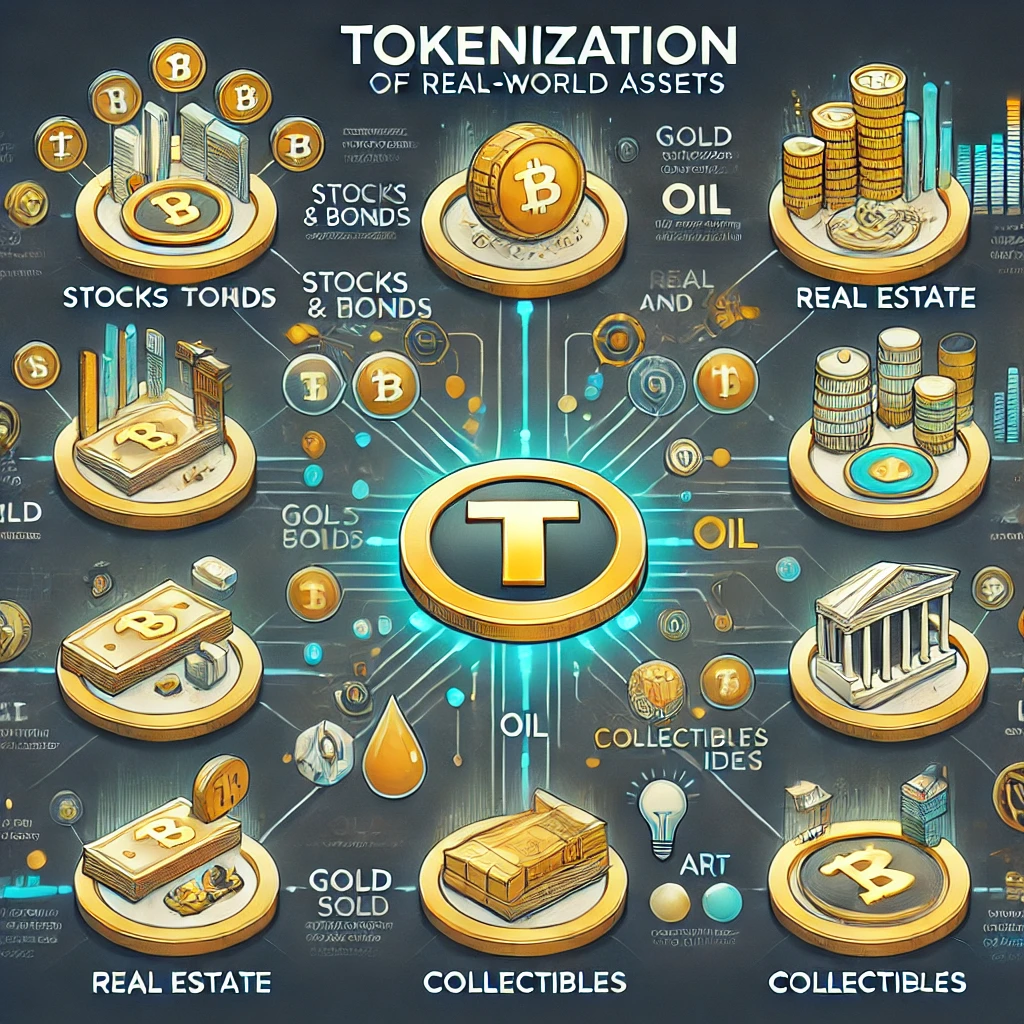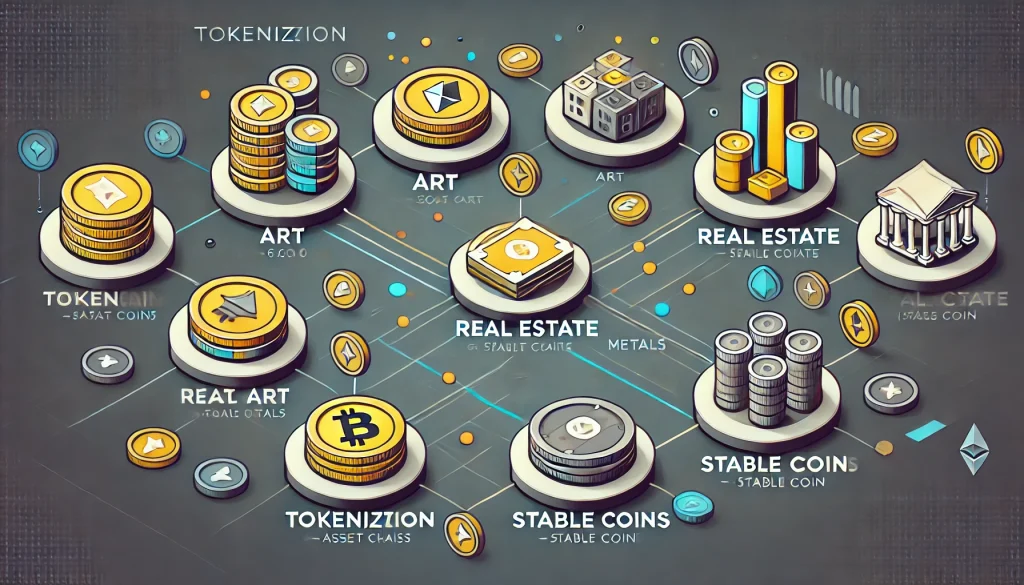

The financial world is accepting a revolutionary concept: tokenization. But what exactly is tokenization, and how does it work? Let’s break it down in clear terms, exploring its benefits, applications, and the underlying processes.

Asset tokenization is essentially taking a real-world asset and turning it into a digital token on a blockchain. This token represents ownership or rights to that asset. It’s like a digital certificate of ownership for things like real estate, stocks, or even intellectual property.
Here are some of the key points about asset tokenization:
Asset tokenization is a relatively new technology, but it has the potential to revolutionize the way we invest and trade assets. (Source: https://www.kaleido.io/blockchain-blog/guide-to-tokenization)
Tokenization involves a well-defined process that transforms a physical or digital asset into a digital token. Here’s a simplified breakdown:
(Source: https://liquidity-provider.com/articles/how-does-tokenization-work-in-blockchain/)
To ensure interoperability and security, tokenization relies on standardized protocols. Here are some of the most prominent token standards used by financial institutions:
ERC-20: Developed on the Ethereum blockchain, ERC-20 is the most widely used standard for fungible tokens (tokens where each unit is identical). It defines a common set of rules for token creation, transfer, and management.
ERC-721: This standard is used for non-fungible tokens (NFTs), where each token is unique and represents a single asset. This standard is ideal for tokenizing unique assets like art, collectibles, or real estate parcels.
ERC-1155: This hybrid standard combines the features of ERC-20 and ERC-721. It allows for the creation of both fungible and non-fungible tokens within a single contract, making it suitable for tokenizing asset collections or bundled offerings.
ERC-1400: This evolving standard focuses on security tokens, representing ownership or investment rights in real-world assets. It incorporates features like compliance checks, dividend distributions, and voting rights.
ERC-1404: This standard is designed for security tokens with embedded KYC/AML (Know Your Customer/Anti-Money Laundering) functionalities. It simplifies investor onboarding and ensures regulatory compliance.
ERC-1410: This standard focuses on privacy-enabled security tokens. It allows for controlled disclosure of ownership information while maintaining regulatory compliance.
ERC-1462: This standard is under development and aims to facilitate the creation of compliant perpetual swaps on the Ethereum blockchain. It could be relevant for tokenizing asset-backed derivatives.
The choice of token standard depends on the specific characteristics of the asset being tokenized and the desired functionalities of the token. (Source: https://www.linkedin.com/pulse/your-guide-asset-tokenization-what-enterprises-should-know/)
Tokenization isn’t just a buzzword; it offers significant advantages for both asset holders and the financial system as a whole. Let’s explore these benefits:
Increased Liquidity: Illiquid assets like real estate or art are traditionally difficult to buy and sell due to high transaction costs and limited buyer pools. Tokenization divides these assets into smaller, more manageable units (fractional ownership), making them more accessible to a wider range of investors. This increases liquidity and facilitates easier trading.
Reduced Costs: Tokenization can streamline administrative processes and eliminate the need for intermediaries like custodians or transfer agents. This translates to reduced operational costs for asset holders.
Enhanced Security: Blockchain technology offers a secure and tamper-proof platform for storing ownership records. This reduces the risk of fraud and errors associated with traditional paper-based systems.
Fractional Ownership Opportunities: Tokenization allows for the creation of fractional ownership models. This enables investors with limited capital to participate in the ownership of high-value assets like real estate or fine art.
Efficient Transactions: Tokenization streamlines transaction processes by automating tasks and eliminating manual reconciliation. This can significantly reduce transaction settlement times and costs.
New Investment Opportunities: Tokenization unlocks new asset classes for institutional investors. They can gain access to previously illiquid assets and diversify their portfolios.
Increased Transparency: Blockchain technology provides a transparent and immutable record of ownership and transactions. This enhances transparency within the financial system and reduces the risk of fraud.
Regulatory Compliance: Tokenization can simplify regulatory compliance by providing a clear audit trail for regulators to track the movement of assets. (Source: https://www.britannica.com/money/real-world-asset-tokenization)
The beauty of tokenization lies in its versatility. Virtually any asset with value can be tokenized, opening doors for a new era of financial inclusion. Here are some real-world examples:
Stocks And Bonds: Want a tiny piece of a big company? Tokenization lets companies create digital tokens that represent bits of ownership. This makes buying into companies like Apple or Google easier and cheaper.
Real Estate: Ever dream of owning a slice of a beach house? Tokenization allows buildings to be split into digital tokens. This lets you co-own them with friends or other people.
Gold, Oil, etc: Gold bars, barrels of oil, even coffee beans – all these can be turned into digital tokens. This makes buying and selling them faster because you don’t have to move the physical stuff around.
Art And Collectibles: That rare baseball card or a one-of-a-kind painting can be a digital token too. This lets people buy and sell these collectibles more easily, without worrying about shipping or damage.
Cool Ideas And Inventions: Have a great idea but need money to develop it? Tokenization can help! You can create tokens that represent ownership in your idea, letting people invest and share the potential profits.
This is just the beginning! As tokenization gets more popular, we might see even more things turned into digital tokens. The future of owning stuff is looking interesting!
Keep in mind: Tokenization is still new, and the rules are being figured out. But it has the potential to change how we invest, own things, and even trade with each other. (Source: https://www.britannica.com/money/real-world-asset-tokenization)
While tokenization itself isn’t a coin, it relies on blockchain technology, the same system that powers cryptocurrencies. Some existing cryptocurrencies already play a role in the tokenization space, and new ones are emerging specifically designed for this purpose. Here’s a glimpse into how cryptocurrencies and tokenization are intertwined, but remember, this is not financial advice:
Some major cryptocurrencies, like Ethereum (ETH), already support tokenization through features that allow for creating and managing digital tokens on their blockchain. These established players offer a familiar and widely adopted platform for tokenization projects.
Think of an IPO (Initial Public Offering) but for tokenized assets. Security tokens representing ownership in real-world assets are offered through STOs. Platforms like Tezos (XTZ) are designed specifically to facilitate STOs, providing a secure and compliant environment for these tokenized security offerings.
New cryptocurrencies are being created specifically to fuel tokenization ecosystems. These utility tokens often have specific functionalities within a particular tokenization project. For example, a tokenization project focused on real estate might have a utility token used for paying fees or accessing exclusive features within their platform.
Source: https://www.linkedin.com/pulse/how-cryptocurrencies-tokens-related-blockchain-development-j7tvc/)
While tokenization offers immense potential, it’s still an evolving technology with inherent risks and challenges to consider:
This new wave of asset tokenization is shaking things up in finance. It’s basically turning real-world assets like property, art, or even sneakers into digital tokens, like little slices of a pie. This opens the door for more people to invest, makes buying and selling a breeze, and keeps everything transparent and easy to track.
There are still some challenges, like figuring out the best rules for this new system and keeping it secure. But as technology advances and we iron out the wrinkles, asset tokenization has the potential to create a financial system that’s both more accessible and efficient for everyone.
You must be logged in to submit a review.
Copyright ©2025 Altcoin Analyst.